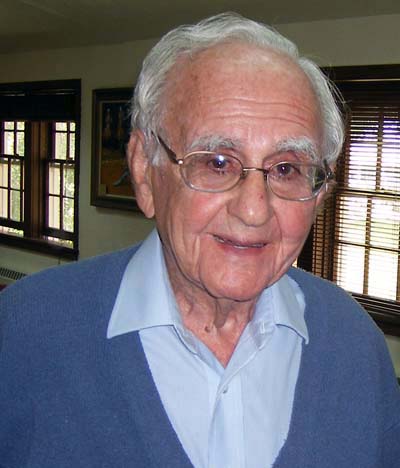By George Cowan
A major legacy of the “Manhattan Project” is that its name and its formula for success have become synonymous with achieving seemingly impossible national objectives. What were the essential elements of the Manhattan Project? I’ve thought about this question often over the years. One thing was clear. A prerequisite for any such model is an enormously compelling challenge. In the case of the Manhattan Project there were two parts to the challenge: 1. The war and the very real prospect of a Fascist world and, 2. The promise of a new weapon so powerful that it would quickly guarantee victory.
Despite differences in the kinds of people that were involved, the Apollo project to send men to the moon in the 1960’s has often been referred to as a second Manhattan Project. It involved a compelling challenge. This challenge attracted a diverse group of truly talented people. Under their leadership NASA was created and went on to develop its huge centers at Cape Canaveral, Houston, Pasadena. It enlisted the organizational and engineering skills of our most imaginative space technology corporations. And, like the first Manhattan Project, it worked. Both of these projects were very large. They were examples of what Harris Mayer has called meta-engineering. They could not have been accomplished without the synthesis of many different interests and capabilities. But they wouldn’t have come into existence at all without initial concepts that were spelled out by a small number of extraordinary people. I want to focus on this prerequisite for success, the truly unique feature of the Manhattan Project model. . . .
I was greatly influenced in subsequent years by my work on the wartime Manhattan Project at Princeton, Chicago, St. Louis, M.I.T., Oak Ridge, Columbia, and Los Alamos. I was thinking in terms of a mini-Manhattan Project when, in the 1980’s I helped put together and manage a small cluster of great people at the Santa Fe Institute. Here the huge challenge was to explore the universality of open, non-linear complex adaptive systems in nearly all of the processes we see in our daily lives. It was and remains a compelling and tremendously important concept, one that is transforming the agenda of the academic, business, and investment worlds. To the extent that it required meta-engineering, a huge base was already being assembled by government and industry in the form of the scientific and industrial explosion of computer technology and the advent of the age of information. The Santa Fe Institute seized on this technology to attack complexity. Its timing happened to be fortunate.
So the Manhattan Project model starts with small, diverse groups of great minds. Formation of such groups requires a compelling challenge that captures these very best minds and requires their collaborative efforts. We can make long lists of problems existing today that suggest a need to adopt the Manhattan Project model. But which of them can inspire groups of extraordinary people to join together and produce truly imaginative conceptual approaches?
I suggest that such a problem is now posed by religious extremists, particularly relatively small groups of fanatics who are rewarded by the use of deadly violence to achieve their ends or by guaranteed entry to Paradise. Bill Press says that the underlying problem must be addressed in a far larger context. Most members of societies that spawn fanatics live in deprived environments. They surely must be open to thoughtful programs that would improve their material well-being. Can we better understand how, at this moment, some of the world’s historically poor societies are successfully moving toward more openness and prosperity? Are we imaginative enough to apply this knowledge to improve the unstable and deprived societies we see all over the world? Let me repeat. We are facing a threat that is real and even imminent. It is probably bigger than Hitler’s threat in the 1930’s and 1940’s. Relatively small numbers of fanatics and thugs are increasingly capable of inflicting intolerable levels of damage on vulnerable targets. They pose a problem that is truly challenging and compelling.
Our civilization has its share of great minds that have not been fully enlisted in addressing this problem. My own biases turn me toward outstanding physical and social scientists, probably mostly in academia. We regard them and provide support for them as great national assets but many are also part of a unique international community that speaks a common language and shares common objectives. Shouldn’t we turn to this community and enlist its help?
There are, of course, troublesome questions in framing a proposal. The central theme of the Manhattan Project was the achievement of a new, overwhelming form of coercive power. Many people were troubled by this objective but, in the end, the theme was widely accepted. A new Manhattan Project would have to explore other forms of power and paths to peace. It wouldn’t start today with a well-defined program. It is unlikely to have immediate support from those who think that the only possible options are economic sanctions on governments followed, if necessary, by military power. The Project would have a considerably bigger challenge than the one that we faced sixty and seventy years ago. The problems involved in dealing with a combination of deprived societies, rogue governments, dispersed militias, and rampant thuggery have no precedent.
It would probably be necessary to begin with a distinguished, high level study group, one that would command wide attention and respect. It would discuss in some detail what paths a new Manhattan Project might begin to explore. The group would be asked to draft a charter for the Project. It would be open to additional ideas. A consensus might then form. Is there sufficient enlightened leadership in Washington or elsewhere to commission such a first step? I hope that the answer is yes and that something like this might happen soon.





